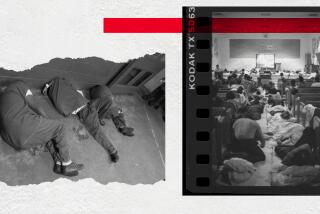Hard-Core Inmates : Prison Gets New, Softer Interior Decor
- Share via
MARION, Ill. — Walls painted in soothing earth tones and gleaming, razor-sharp barbed wire.
The two mix easily in the view of Gary L. Henman, who last June became warden of the nation’s toughest prison, the U.S. Penitentiary at Marion.
Henman, 46, is in charge of a major, three-year renovation of the maximum-security lockup, and he says he wants to give it a more humane appearance. The work began before he took over, but Henman plans to add a personal touch:
“I’m big on graphics and earth tones. It gives you a little sense of warmth,” Henman said. “We want to make the place as bright and cheerful as it can be.”
He mentioned research that has shown that certain “soft” colors have a quieting effect on behavior, and quiet behavior is something often in short supply in the confined and confrontational world of Marion, where most inmates are in their cells 23 hours a day.
“If it looks like a cage or looks like a hole, that’s what it is,” Henman said.
With a softer image in mind, he ordered decorative changes in the prison’s interior.
Furniture Will Be Hard
Security, however, is never far from his mind. In addition to new paint, inmates will be getting new furniture--all made of concrete. Concrete bed frames, shelves, tables and desks.
Something seemingly so innocent as a chair leg or metal footlocker can be deadly inside Marion, Henman said.
“Metal and wood are prime materials for making weapons,” Henman explained.
There are no earth tones in Henman’s view of the Marion “mission,” as the federal Bureau of Prisons calls it. That mission, according to Henman, is to isolate the most violent and escape-prone inmates so that other prisoners are safer and other prisons can be run more openly.
“These inmates are the failures from throughout the Bureau of Prisons,” he said. “When you get here, you’re at a dead end. This is it.”
Marion has been locked down since 1983, when several guards and inmates were killed in prison violence. With the exception of about 43 inmates in the pre-release area, life here is defined by cell walls. Those in pre-release and a few others in an intermediate section are allowed to work at a small prison industry and to eat outside their cells.
Most Kept in Cells
The majority of inmates eat, sleep, write, read and even exercise in their cells. Educational programs are piped in on television. Mail and phone calls are monitored. Inmates and their visitors are separated by glass and talk over a phone.
Henman, who holds a doctorate in social work, says he won’t engage in philosophical debate with Marion’s sharpest critic, the Marion Prisoner Rights Project. He says he fully expects his attempt to make Marion more “cheerful” to draw ridicule from that group.
“You just can’t win in those debates,” he said. “It’s a basic philosophical difference.”


